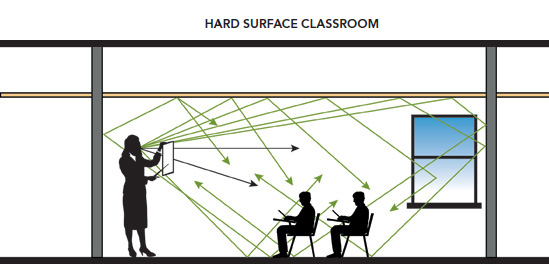Innovations in Acoustical Ceilings for Today’s Flexible Interiors
Total Acoustic Quality for Classrooms
Teachers and students do their best in an environment that is conducive to learning. A poor acoustical environment will often increase stress and decrease concentration, especially in these cases:
► Students with hearing impairments or learning disorders.
► Very young children—These students require good acoustic conditions because much of the material and vocabulary is new to them. Because these students have limited vocabularies, they are less able to fill in missing words and phrases not heard clearly.
► English as a Second Language Students —The number of non-English-speaking students is growing in the American school system. These students are at more of a risk than native speakers in a noisy classroom because they are often learning the language as well as the curriculum.
► Students with Temporary Hearing Impairment—Illness often causes hearing loss in children. Research shows that middle-ear infection is the most frequently occurring medical condition in young children, with incidences as high as 25 percent among kindergarten and first grade students.
► Teachers at Risk of Burnout—When teachers must constantly raise their voices to overcome noise, vocal chords become fatigued. Teachers become stressed and frustrated trying to talk “over” the noise.


Images courtesy of Armstrong® Commercial Ceilings
The addition of sound-absorbing materials reduces late-arriving sound, lowers reverberation time, and improves speech intelligibility.
These are sources of unwanted noise in the classrooms:
Reflected Sound—Reflected sound takes longer to reach the listener than direct sound because its path to the listener is longer. Reflected sound can be good or bad depending on the time delay and the surface from which it is reflected.
Reverberation— Short reverberation times are good for speech intelligibility.
Background Noise—This may include interior noise sources such as HVAC system and corridor noise plus environmental noise generated outside the building, such as playground activity, traffic and planes.
ANSI Standard S12.60
ANSI Standard S12.60 for classroom acoustics addresses the issues of both reverberation time and background noise and their effect on speech intelligibility by placing maximum permissible levels on each.
The reverberation times (RTs) required ensures that the speech will be clear, and the maximum decibels (dBA) of background noise ensures that the signal-to-noise ratio will be adequate for the speaker to be heard above the noise. Under this new standard, the maximum reverberation time in an unoccupied, furnished classroom with a volume less than 10,000 cubic feet is 0.6 seconds, and 0.7 seconds for a classroom between 10,000 and 20,000 cubic feet. The maximum level of background noise allowed in the same classroom is 35 dBA.
The standard's acoustical performance criteria and design requirements apply during the design and construction of all new classrooms or learning spaces of small-to-moderate size, and, as far as is practical, to the design and reconstruction of renovated spaces.
Note that the new ANSI standard is voluntary unless referenced by a code, ordinance or regulation. However, school systems may require compliance with the standard as part of their construction documents for new schools. Additionally, many states mandate that new schools meet LEED ratings along with ANSI requirements.
One solution to comply with the ANSI standard is to reduce reflected sound. The level of reflected sound and the reverberation time can both be reduced by adding sound absorbing material to a room. The placement of those materials depends on the situation.
For classrooms in lower grades, or where ceiling heights are less than 10 feet, the best option is to place most, if not all, the sound-absorbing material in the ceiling. To reduce reverberation, specify a ceiling panel with an NRC of at least 0.70.
Wall treatments and furnishings can help. Plus, carpeting can help reduce reflected sound, but most carpeting materials used in schools have an NRC lower than 0.25 and most of it is covered with tables and chairs. Still, it can reduce noise from chair and foot impacts, both in the room of origin and the room below.
Reducing noise traveling through the plenum from adjacent spaces is important to consider. Walls do not always extend all the way up to the finished deck of the floor above. Instead they often stop at the suspended ceiling line. As a result, noise in an adjacent space can reflect off the deck and bounce back down through the ceiling into an adjoining classroom. To help reduce this type of noise intrusion, choose an acoustical ceiling panel that has a high CAC value, which will help block the sound between two rooms that share a common plenum. The suspended ceiling can also be back loaded with fiberglass insulation batts. Another solution is to install a gypsum board plenum barrier between the adjacent rooms and sealing all penetrations.
Classroom Study Project
A classroom case study was conducted by architect Micaelina Campos that illustrates the effect of acoustical treatment in an existing classroom.5 The test was in response to teachers in a local school who were complaining about the vocal effort required to teach. The problem was a very high reverberation time and a high level of background noise from the street. Campos offered to conduct a test to see if the proposed solution would work. She selected four essentially identical classrooms. The design of the rooms was typical for the area, namely, hardwood floors, masonry walls, high masonry ceilings and tall windows.
Campos treated two rooms acoustically, and left the other two untreated to function as “control” rooms. To improve the acoustical environment in the treated rooms, Campos employed a three-step solution:
1. Installation of a suspended ceiling with an NRC of 0.70 and CAC of 35.
2. Application of a wall treatment across the top portion of the back wall.
3. A reduction in the size of the windows followed by the installation of a second pane of glazing.
The acoustical results of the treatment were dramatic. Reverberation time went from 2.6 seconds to 0.6 seconds. And the level of background noise went from 66 dBA during peak street noise hours to a low of 38 dBA.
However, acoustical results were not the only measures of success. A number of subjective factors were also investigated. For example, teachers were asked how they felt after teaching in the treated classrooms.
► There was an 80% increase in the level of satisfaction.
► Fewer voice problems was one of the most common reasons given.
► Before acoustical treatment, 57.5% of total teacher absences were due to voice/throat problems.
► After treatment, only 34.7% were due to the same problem.
The most telling measure of success came from parents, who, after moving their weekly association meetings from one of the non-treated classrooms to a treated one, decided to conduct all their subsequent meetings in the treated classroom, and to install acoustical treatments in the remainder of classrooms.
While there is an obvious need for high NRC and CAC ceilings in many projects, specifying the best material can be complicated. The next section will focus on that.










